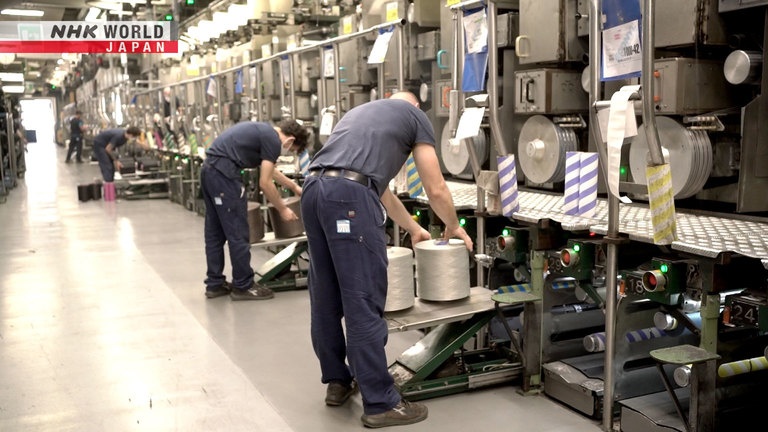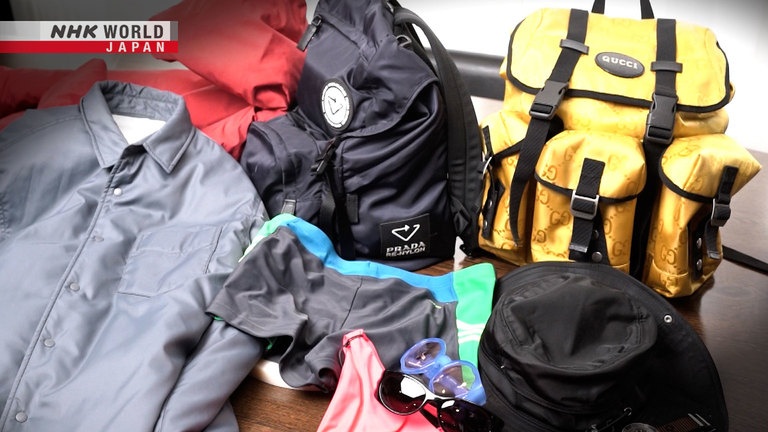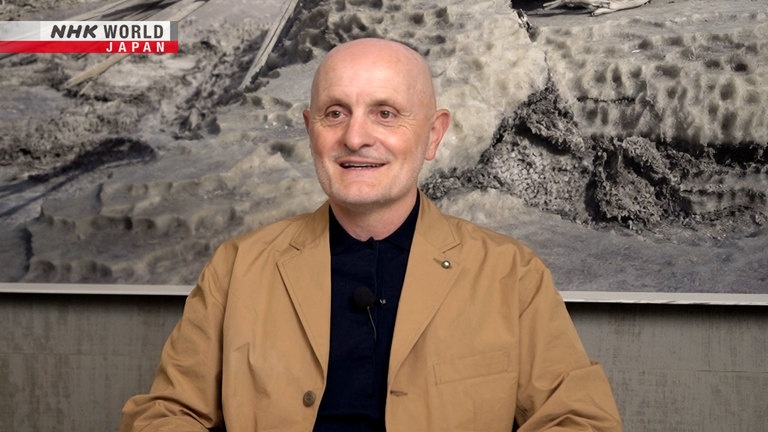Turning Waste Into Luxury Brands: Giulio Bonazzi / Chairman and CEO at Aquafil Group
Giulio Bonazzi takes nylon waste such as fishing nets and carpets to recycle them into ECONYL(R) nylon. He is reshaping the fashion industry that's been behind with environmental measures.



Transcript
Direct Talk
The fashion industry has been hit hard
by the war in Ukraine
That's as many textile industries
depend on petroleum-based materials
which have been soaring in price.
Giulio Bonazzi has come under the spotlight
due to these circumstances
He is the Chief Executive of Italy's Aquafil.
His company uses revolutionary technology
and turns used synthetic materials
into a fiber called ECONYL.
Waste is used
and there is obviously less dependency on
gas, oil, and coal suppliers.
Many luxury brands
have started using Bonazzi's
regenerated nylon as prices of
synthetic materials go up.
Major trading companies and manufacturers
are also keen on the new technology
and have started its use.
We ask him where the fashion and textile
industries are headed with "innovation"
as they face the current challenges.
Turning Waste Into Luxury Brands
Nylon has been recycled for many decades,
but with conventional technologies
in the classic mechanical cycle
as plastic for motor vehicles
or other applications.
While ECONYL is the only
manufacturing plant nowadays
capable of recycling
post-consumption nylon waste.
Rather than starting the process
from products develop from oil refining,
it starts entirely from waste
like fishing nets, carpets, rugs,
plastic products or textiles
that come from usage
and not from pre-industrial recycling.
Nylon is a strong synthetic material
made from petroleum.
Nylon
Yet it's difficult to recycle
using conventional methods.
It's used for fishing nets
and carpet among other items.
Used nets often turn into waste in the ocean.
It's becoming 10% of all marine debris
having a huge impact on the environment
not only floating on the water
but washing up on seashores.
Bonazzi's Aquafil is a pioneer
in the reuse of this discarded material.
Aquafil Headquarter
Arco, Italy
He chemically treats the thrown away nets,
rags and carpets
and makes the recycled product ECONYL.
The upcycling method turns
what was once thrown away
into a high-quality product
that is eco-friendly
and is attracting global attention.
The thread is starting to be used by
various well-known brands around the world.
ECONYL is nylon,
it is nothing but nylon.
Using ECONYL is easy for clients
because they don't have to change anything,
so we don't give any limitations
to designers and engineers
in creating their beautiful products.
I acknowledge that at first
it was difficult to introduce the product,
but then a series of companies
and people fell in love with ECONYL,
like for example Stella McCartney,
who was one of the first ones to adopt it,
or Gucci, who made ECONYL famous
in the fashion industry as luxury products,
and from there,
today we have more than 2000 customers
in the world who use ECONYL.
Another example I must mention is
the Kering conglomerate organization.
It had a group of people who were doing
research on sustainable materials,
and here they learned about ECONYL
and use it in their brands and subsidiaries.
ECONYL has become the center of attention
due to the nature of the fashion industry.
The so-called low priced fast fashion
is leading to
large amounts of discarded clothes.
Fast fashion also uses
abundant amounts of water and energy
despite its low recycling rate.
In 2019 the United Nations has called for
urgent improvements in the fashion,
textile, and other related businesses
to become more eco-friendly.
The fashion industry should absolutely change
because it is becoming
one of the sectors that unfortunately
pollutes the most
and contributes the most to climate change
due to the emissions it generates.
ECONYL with its special process
has an intrinsic content of energy
that is more than 60%
less than conventional nylon.
There is neither hazardous materials,
nor solvents,
and nothing is used
except steam energy and heat,
and just a small amount of a catalyst
that is used in the food industry to
speed up the depolymerization reaction.
Additionally, Aquafil uses energy
coming entirely from renewable sources,
so we succeeded in
committing a carbon footprint of
less than 90% compared to conventional nylon.
By taking resources from the planet
and contributing to putting
harmful substances in the atmosphere,
sooner or later
we would reach a point of no return
and to a solution that was no longer
sustainable economically or environmentally.
So, I began to rethink about
what needed to be done.
Aquafil that makes ECONYL
was founded in 1965 by Bonazzi's father.
Giulio Bonazzi took over the business in 2001.
That's when he realized
that the textile industry
was highly dependent on petroleum
and vulnerable to its supply.
So recycling nylon
became part of his mission.
At the beginning everyone was smiling,
our competitors were
all convinced that we had failed.
Others had tried before us,
very big and important companies
tried and failed.
Why?
Because it is difficult
to explain it in two words.
In the spring of 2008,
a CEO of one of Europe's largest banks
came to me to hear
what my approach and philosophy was.
I told him about ECONYL
and what we wanted to do,
we wanted to make only recycled products
and change the way we made products
That gentleman literally
jumped out of his chair, walked away,
and said to me
"I will never lend you a euro."
We made mistakes,
but we convinced ourselves
that we didn't have to go back.
So, there has always been from my side
all the support to our people
and to our technicians
to get to the concrete solutions
to recycle nylon,
it took several years
but we finally succeeded.
In 2011 the production of ECONYL was started.
Aquafil collaborated with
various environmental groups
and governments around the world
to efficiently source discarded
nylon products.
In the area of fishing net collection,
we have discovered at least
for those who make fishing nets
for aquaculture or for large fishing vessels,
that there are companies that
do a net maintenance service,
and they were our first, let's say,
relationships, our first connections
that instead of sending the mats
to landfill or incineration,
they started sending them to us.
Today we are also engaged directly
with the collection of these, fishing nets,
in Norway we have a holding company
that collects fishing nets that are used in
salmon farming and other fish.
In carpet and rugs,
we are focused in California
because there is a so called
extended responsibility program
of the producer,
so let's say there is an
organized system by the state
for there to be fees and
contributions for those who
instead of sending the carpets to the landfill,
collect them and then recycle them.
Today we not only have
our own facility to recycle carpets,
but we have even started
to collect carpets directly.
It's either done relatively simply
by putting bins directly
at the carpet and rug sellers
or it's done directly with the installers,
the ones who come to people's homes
to exchange the old carpet
for the new carpet.
If one goes at 5 a.m. in Phoenix,
to our collection center,
one sees the line of pickup trucks
and there is the line of people
who come and bring the carpet
they dismantled the previous day
from Mr. Smith's or Mrs. White's.
The pandemic and war in Ukraine
have impacted Bonazzi's mission
of recycling nylon.
He now has a strong sense of urgency
than ever before to speed up reforms.
Covid and war,
this terrible problem of war,
were two moments that absolutely
raised awareness of the need for change.
War is showing that especially for Europe,
energy dependency and
indiscriminate energy consumption,
unfortunately causes
far more serious problems
than those of the environment.
Europe has already set
very important goals for itself,
but other countries, like Japan,
which is certainly ahead in this respect,
are developing legislation to
make producers accountable for what they do,
not only for the profits
but also for the way resources are used.
So we have validated until today
a very important set of waste,
worth potentially
several million tons to recycle
but we still have many other types of waste
where to develop technology specifically
to be able to recycle them.
There is still a lot of work to be done.
Aquafil uses 2% of its revenue
for research and development.
That includes coming up
with recycling technologies
but also on the innovation of
conventional synthetic fibers.
Even if you recycle
100 percent of the products,
and that will not always be possible,
this will never be able to meet the
world's demand for nylon or plastic or fiber.
so recycling is not enough
to guarantee enough resources coming from
the planet for future generations.
You also have to produce the primary product,
the one before recycling, in a sustainable way.
Now nylon 6 is a unique case,
I call it a super molecule
because it can come from petroleum
in its conventional technology,
and it can also be recycled perfectly
through the ECONYL depolymerization system,
or it can also come from sugar fermentation,
so from renewable raw materials.
This is what we are doing with Genomatica.
We have already produced more than
two tons of this bio-based nylon
and now we have a demonstration plant,
which is a real plant,
no longer a pilot
but already a small industrial plant
that produced 50 kg/hr in operation
for about eight weeks in Ljubljana, Slovenia.
We are all still at the beginning
of this incredible adventure.
Bonazzi left us with these words.
When I see a landfill, I see a gold mine.
This is a very important thing
because we need to start thinking of waste
as one of our greatest resources,
it should no longer be a problem,
but on the contrary,
it should be an opportunity.